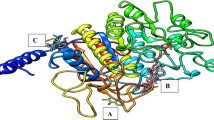Abstract
Inhibition of benzo[a]pyrene (B[a]P)-induced cytotoxicity and cytochrome p450 1A (CYP 1A) activity by flavonoids (1–100 μM) was examined in terms of the structure-activity relationship in the human liver-derived cell model (HepG2). Two hydroxyl groups in the 5- and 7-position of flavonoids were essential to inhibit B[a]P-induced cytotoxicity. Generally, flavones (IC50; 5.0–17.2 μM) were more potent than the corresponding flavonols (IC50; 42.7–131.8 μM), and flavonoids such as apigenin (IC50; 7.2 μM) were more active than the corresponding isoflavonoids, genistein (IC50; 61.7 μM). The planar structure of flavone proved to be important in inhibiting B[a]P-induced toxicity and CYP 1A activity. The inhibitory effect of flavonoids on B[a]P-induced CYP 1A activity was correlated well with the inhibition of B[a]P-induced cytotoxicity (r=0.635, p<;0.01).
Similar content being viewed by others
References
Cassady JM, Baird WM, Chang CJ (1990) Natural products as a source of potential cancer chemotherapeutic and chemopreventive agents. J. Natl. Prod. 53: 23–41.
Cassady JM, Zennie TM, Chae YH, Ferin MA, Portuondo NE, Baird WM (1988) Use of a mammalian cell culture benzo[a]pyrene metabolism assay for the detection of potential anticarcinogens from natural products: inhibition of metabolism by biochanin A, an isoflavone from Trifolium pratense L. Cancer Res. 48: 6257–6261.
Chae YH, Ho DK, Cassady JM, Cook VM, Marcus CB, Baird WM (1992) Effects of synthetic and naturally occurring flavonoids on metabolic activation of benzo[a]pyrene in hamster embryo cell cultures. Chem.Biol. Interact. 82: 181–193.
Das M, Mukhtar H, Bik DP, Bickers DR (1987a) Inhibition of epidemal xenobiotic metabolism in SENCAR mice by naturally occurring plant phenols. Cancer Res. 47: 760–766.
Das M, Khan WA, Asokan P, Bickers DR, Mukhtar H (1987b) Inhibition of polycyclic aromatic hydrocarbon-DNA adduct formation in epidermis and lungs of SENCAR mice by naturally occurring plant phenols. Cancer Res. 47: 767–773.
Doehmer J, Holtkamp D, Soballa V, Raab G, Schmalix W, Seidel A, Greim H, Jacob J (1995) Cytochrome P450 mediated reactions studied in genetically engineered V79 Chinese hamster cells. Pharmacogenetics 5: S91-S96.
Grant MH, Duthie SJ, Gray AG, Burke MD (1988) Mixed function oxidase and UDP-glucuronyltransferase activities in the human HepG2 hepatoma cell line. Biochem. Pharmacol. 37: 4111–4116.
Havsteen B (1983) Flavonoids, a class of natural products of high pharmacological potency. Biochem. Pharmacol. 32: 1141–1148.
Huang MT, Wood AW, Newmark HL, Sayer JM, Yagi H, Jerina D, Conney AH (1983) Inhibition of the mutagenicity of bay-region diol-epoxides of polycyclic aromatic hydrocarbons by phenolic plant flavonoids. Carcinogenesis 4: 1631–1637.
Lahiri M, Bhide SV (1993) Effect of four plant phenols, betacarotene and alpha-tocopherol on 3(H) benzopyrene-DNA interaction in vitro in the presence of rat and mouse liver postmitochondrial fraction. Cancer Lett. 73: 35–39.
Limbosch S (1983) Benzo[a]pyrene and aldrin metabolizing activities in cultured human and rat hepatoma cell lines. J. Natl. Cancer Inst. 71: 281–286.
Mosmann T (1983) Rapid colorimetric assay for cellular growth and survival: application to proliferation and cytotoxicity assays. J. Immunol. Meth. 65: 55–62.
Nagao A, Seki M, Kobayachi H (1999) Inhibition of xanthine oxidase by flavonoids. Biosci. Biotechnol. Biochem. 63: 1787–1790.
Ohgiya S, Kii T, Goda T, Hoshino T, Hamabuchi K, Yokota H, Yuasa A, Ishizaki K (1997) Improvement in the expression efficiency of mammalian cytochrome P450 and NADPH-cytochrome P450 oxidoreductase in Saccharomyces cerevisiae. Biotechnol. Lett. 19: 437–441.
Sassa S, Sugita O, Galbraith RA, Kappas A (1987) Drugmetabolism by the human hepatoma cell, HepG2. Biochem. Biophys. Res.Commun. 143: 52–57.
Schladt L, Wörner W, Setiabudi F, Oesch F (1986) Distribution and inducibility of cytosolic epoxide hydrolase in male Spraguedawley rats. Biochem. Pharmacol. 35: 3309–3316.
Shou M, Korzekwa KR, Crespi CL, Gonzalez FJ, Gelboin HV (1994) The role of 12 cDNA-expressed human, rodent, and rabbit cytochrome P450 in the metabolism of benzo[a]pyrene and benzo[a]pyrene trans-7, 8-dihydrodiol. Mol. Carcinogen. 10: 159–168.
Siess MH, Le-Bon AM, Suschetet N, Rat D (1990) Inhibition of ethoxyresorufin deethylase activity by natural flavonoids in human and rat liver microsomes. Food Addit. Contam. 7: S178-S181.
Siess MH, Pennec A, Gaydou E (1989) Inhibition of ethoxyand pentoxy-resorufin dealkylases of rat liver by flavones and flavonols: structure-activity relationship. Eur. J. Drug Metab. Pharmacol. 14: 235–239.
Vernet A, Siess MH (1986) Comparison of the effects of various flavonoids on ethoxycoumarin deethylase activity of rat intestinal and hepatic microsomes. Food Chem. Toxicol. 24: 857–861.
Wortelboer HM, De Kruif CA, Van Iersel AAJ, Falke HE, Noordhoek J, Blaauboer BJ (1990) The isoenzyme pattern of cytochrome P450 in rat hepatocytes in primary culture, comparing different enzyme activities in microsomal incubations and in intact monolayers. Biochem. Pharmacol. 40: 2525–2534.
Author information
Authors and Affiliations
Rights and permissions
About this article
Cite this article
Kim, HJ., Chun, HS. & Yang, R. Inhibition of benzo[a]pyrene-induced cytotoxicity and cytochrome P450 1A activity by dietary flavonoids in human liver cell model: structure-activity relationship. Biotechnology Letters 22, 1941–1946 (2000). https://doi.org/10.1023/A:1026749606363
Issue Date:
DOI: https://doi.org/10.1023/A:1026749606363




